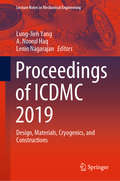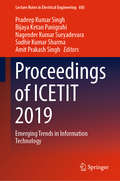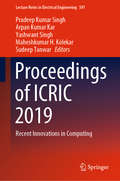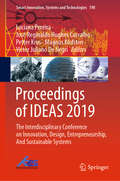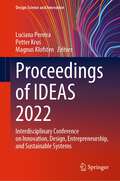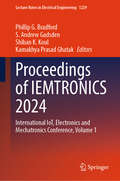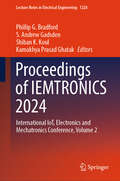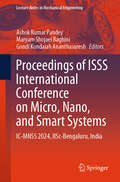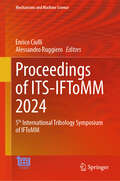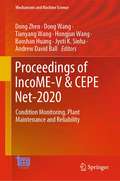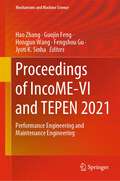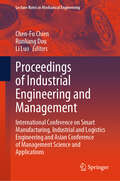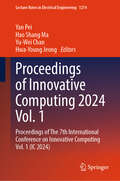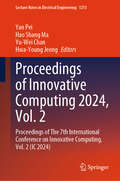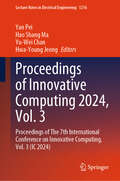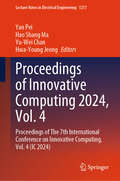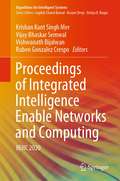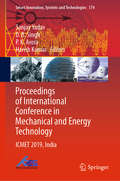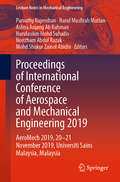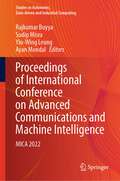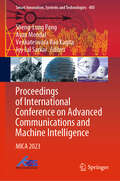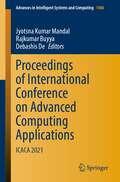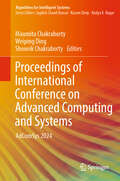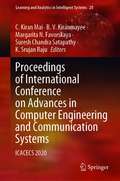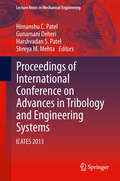- Table View
- List View
Proceedings of ICDMC 2019: Design, Materials, Cryogenics, and Constructions (Lecture Notes in Mechanical Engineering)
by Lung-Jieh Yang A. Noorul Haq Lenin NagarajanThis book comprises select proceedings of the International Conference on Design, Materials, Cryogenics and Constructions (ICDMC 2019). The chapters cover latest research in different areas of mechanical engineering such as additive manufacturing, automation in industry and agriculture, combustion and emission control, CFD, finite element analysis, and engineering design. The book also focuses on cryogenic systems and low-temperature materials for cost-effective and energy-efficient solutions to current challenges in the manufacturing sector. Given its contents, the book can be useful for students, academics, and practitioners.
Proceedings of ICETIT 2019: Emerging Trends in Information Technology (Lecture Notes in Electrical Engineering #605)
by Bijaya Ketan Panigrahi Pradeep Kumar Singh Nagender Kumar Suryadevara Sudhir Kumar Sharma Amit Prakash SinghThis book presents high-quality, original contributions (both theoretical and experimental) on Information Security, Machine Learning, Data Mining and Internet of Things (IoT). It gathers papers presented at ICETIT 2019, the 1st International Conference on Emerging Trends in Information Technology, which was held in Delhi, India, in June 2019. This conference series represents a targeted response to the growing need for research that reports on and assesses the practical implications of IoT and network technologies, AI and machine learning, data analytics and cloud computing, security and privacy, and next generation computing technologies.
Proceedings of ICRIC 2019: Recent Innovations in Computing (Lecture Notes in Electrical Engineering #597)
by Arpan Kumar Kar Pradeep Kumar Singh Maheshkumar H. Kolekar Sudeep Tanwar Yashwant SinghThis book presents high-quality, original contributions (both theoretical and experimental) on software engineering, cloud computing, computer networks & internet technologies, artificial intelligence, information security, and database and distributed computing. It gathers papers presented at ICRIC 2019, the 2nd International Conference on Recent Innovations in Computing, which was held in Jammu, India, in March 2019. This conference series represents a targeted response to the growing need for research that reports on and assesses the practical implications of IoT and network technologies, AI and machine learning, cloud-based e-Learning and big data, security and privacy, image processing and computer vision, and next-generation computing technologies.
Proceedings of IDEAS 2019: The Interdisciplinary Conference on Innovation, Design, Entrepreneurship, And Sustainable Systems (Smart Innovation, Systems and Technologies #198)
by Luciana Pereira José Reginaldo Hughes Carvalho Petter Krus Magnus Klofsten Victor Juliano De NegriThis book presents the proceedings of the IDEAS Conference, which is intended as a forum for a new generation of researchers. IDEAS is an arena that encourages researchers to defy their field's boundaries, leveraging disciplinary mindset into contributions to broad domains within the Science, Technology, Engineering, Entrepreneurship, and Management. Further, IDEAS explores novel questions and challenges existing policies and practices on how to apply science and technology as an input to design more innovative and sustainable systems that promote human well-being.
Proceedings of IDEAS 2022: Interdisciplinary Conference on Innovation, Design, Entrepreneurship, and Sustainable Systems (Design Science and Innovation)
by Luciana Pereira Petter Krus Magnus KlofstenThis book explores the cutting-edge ideas that are shaping the future of innovation, design, entrepreneurship, and sustainability. The proceedings of the interdisciplinary Conference on Innovation, Design, Entrepreneurship, and Sustainable Systems offer new perspectives on these topics. This book navigates the most recent research trends and practices, and gains unique insights on how to address innovation, design, and entrepreneurship on a sustainable basis. This book is an essential reference for anyone interested in staying up to date on the latest research, whether they are academics, designers, entrepreneurs, or sustainability enthusiasts. Get your copy now and take part in the debate about the future of sustainable innovation.
Proceedings of IEMTRONICS 2024: International IoT, Electronics and Mechatronics Conference, Volume 1 (Lecture Notes in Electrical Engineering #1229)
by Kamakhya Prasad Ghatak Shiban K. Koul Phillip G. Bradford S. Andrew GadsdenThis book gathers selected research papers presented at IEMTRONICS 2024 (International IoT, Electronics and Mechatronics Conference), held during 3–5 April 2024 in London, United Kingdom in hybrid mode. This book presents a collection of state-of-the-art research work involving cutting-edge technologies in the field of IoT, electronics mechatronics, and related areas. The work is presented in two volumes.
Proceedings of IEMTRONICS 2024: International IoT, Electronics and Mechatronics Conference, Volume 2 (Lecture Notes in Electrical Engineering #1228)
by Kamakhya Prasad Ghatak Shiban K. Koul Phillip G. Bradford S. Andrew GadsdenThis book gathers selected research papers presented at IEMTRONICS 2024 (International IoT, Electronics and Mechatronics Conference), held during 3 – 5 April 2024 in London, United Kingdom in hybrid mode. This book presents a collection of state-of-the-art research work involving cutting-edge technologies in the field of IoT, electronics mechatronics, and related areas. The work is presented in two volumes.
Proceedings of ISSS International Conference on Micro, Nano, and Smart Systems: IC-MNSS 2024, IISc-Bengaluru, India (Lecture Notes in Mechanical Engineering)
by Gondi Kondaiah Ananthasuresh Ashok Kumar Pandey Maryam Shojaei BaghiniThis book presents select proceedings of the ISSS International Conference on Micro, Nano, and Smart Systems (IC-MNSS) in IISc Bengaluru during July 9 to 12, 2024 and presents different applications of smart materials and systems in aerospace, robotics, quantum, agriculture, and biomedical technologies followed by microfabrication processes and packaging technologies required to design and develop different sensors on micro and nanoscale. The first few chapters cover shape memory alloys (SMA) and its modelling and remaining chapters outline the application of smart systems and materials in quantum technology, digital agriculture, and healthcare. After describing the microfabrication processes in bulk and surface micromachining processes, the design and development of various sensors are demonstrated in the last few chapters. The book is valuable to researchers and professionals working in the area of micro and nano-based design, fabrication, and development of sensors, and their application in smart systems, water purification, and energy harvesting.
Proceedings of ITS-IFToMM 2024: 5th International Tribology Symposium of IFToMM (Mechanisms and Machine Science #160)
by Alessandro Ruggiero Enrico CiulliThis book presents the proceedings of the 5th International Tribology Symposium of IFToMM (ITS-IFToMM 2024), held in Salerno, Italy, on May 6th-8th, 2024, jointly with the 9th AIT (Italian Tribology Association) Workshop “Tribology and Industry”. It includes peer-reviewed papers on the latest advances in tribology, discussing topics such as friction, wear, lubrication, lubricants, biotribology, tribomaterials, solid lubricants, surface engineering, tribotesting, tribological design and optimization of machine components, modeling in tribology, contact mechanics, micro/nanotribology, tribology in power generating systems, metal working tribology, tribology in road transport and tribology in medicine. A valuable, up-to-date resource, it offers an essential overview of the subject for scientists and practitioners alike and inspires further investigations and research.
Proceedings of IncoME-V & CEPE Net-2020: Condition Monitoring, Plant Maintenance and Reliability (Mechanisms and Machine Science #105)
by Jyoti K. Sinha Dong Wang Dong Zhen Tianyang Wang Hongjun Wang Baoshan Huang Andrew David BallThis volume gathers the latest advances, innovations and applications in the field of condition monitoring, plant maintenance and reliability, as presented by leading international researchers and engineers at the 5th International Conference on Maintenance Engineering and the 2020 Annual Conference of the Centre for Efficiency and Performance Engineering Network (IncoME-V & CEPE Net-2020), held in Zhuhai, China on October 23-25, 2020. Topics include vibro-acoustics monitoring, condition-based maintenance, sensing and instrumentation, machine health monitoring, maintenance auditing and organization, non-destructive testing, reliability, asset management, condition monitoring, life-cycle cost optimisation, prognostics and health management, maintenance performance measurement, manufacturing process monitoring, and robot-based monitoring and diagnostics. The contributions, which were selected through a rigorous international peer-review process, share exciting ideas that will spur novel research directions and foster new multidisciplinary collaborations.
Proceedings of IncoME-VI and TEPEN 2021: Performance Engineering and Maintenance Engineering (Mechanisms and Machine Science #117)
by Hao Zhang Jyoti K. Sinha Hongjun Wang Guojin Feng Fengshou GuThis volume gathers the latest advances, innovations and applications in the field of condition monitoring, plant maintenance and reliability, as presented by leading international researchers and engineers at the 6th International Conference on Maintenance Engineering and the 2021 conference of the Efficiency and Performance Engineering Network (IncoME-VI TEPEN 2021), held in Tianjin, China on October 20-23, 2021. Topics include vibro-acoustics monitoring, condition-based maintenance, sensing and instrumentation, machine health monitoring, maintenance auditing and organization, non-destructive testing, reliability, asset management, condition monitoring, life-cycle cost optimisation, prognostics and health management, maintenance performance measurement, manufacturing process monitoring, and robot-based monitoring and diagnostics. The contributions, which were selected through a rigorous international peer-review process, share exciting ideas that will spur novel research directions and foster new multidisciplinary collaborations.
Proceedings of Industrial Engineering and Management: International Conference on Smart Manufacturing, Industrial and Logistics Engineering and Asian Conference of Management Science and Applications (Lecture Notes in Mechanical Engineering)
by Chen-Fu Chien Li Luo Runliang DouThis book is a compilation of selected papers from the 3rd International Conference on Smart Manufacturing, Industrial & Logistics Engineering (SMILE2023) and the 7th Asian Conference of Management Science and Applications (ACMSA2023). The book focuses on the recent theoretical and methodological developments, significant technical applications, case studies, and survey results in the areas of manufacturing informatics, manufacturing intelligence, big data analytics and data mining, modeling and decision analysis, Internet of Things, green supply chains, and intelligent logistics. The book makes valuable contributions to academic researchers and engineers in smart manufacturing, industrial engineering, and logistics, as well as readers will encounter new ideas to promote Digital Intelligence Transformation.
Proceedings of Innovative Computing 2024 Vol. 1: Proceedings of The 7th International Conference on Innovative Computing Vol. 1 (IC 2024) (Lecture Notes in Electrical Engineering #1214)
by Hwa-Young Jeong Yu-Wei Chan Yan Pei Hao Shang MaThis book comprises select proceedings of the 7th International Conference on Innovative Computing which was held in Taichung City, Taiwan, Jan 23-26, 2024 (IC 2024) focusing on cutting-edge research carried out in the areas of information technology, science, and engineering. Some of the themes covered in this book are cloud communications and networking, high performance computing, architecture for secure and interactive IoT, satellite communication, wearable network and system, infrastructure management, etc. The essays are written by leading international experts, making it a valuable resource for researchers and practicing engineers alike.
Proceedings of Innovative Computing 2024, Vol. 2: Proceedings of The 7th International Conference on Innovative Computing, Vol. 2 (IC 2024) (Lecture Notes in Electrical Engineering #1215)
by Hwa-Young Jeong Yu-Wei Chan Yan Pei Hao Shang MaThis book comprises select proceedings of the 7th International Conference on Innovative Computing which was held in Taichung City, Taiwan, Jan 23-26, 2024 (IC 2024) focusing on cutting-edge research carried out in the areas of information technology, science, and engineering. Some of the themes covered in this book are cloud communications and networking, high performance computing, architecture for secure and interactive IoT, satellite communication, wearable network and system, infrastructure management, etc. The essays are written by leading international experts, making it a valuable resource for researchers and practicing engineers alike.
Proceedings of Innovative Computing 2024, Vol. 3: Proceedings of The 7th International Conference on Innovative Computing, Vol. 3 (IC 2024) (Lecture Notes in Electrical Engineering #1216)
by Hwa-Young Jeong Yu-Wei Chan Yan Pei Hao Shang MaThis book comprises select proceedings of the 7th International Conference on Innovative Computing which was held in Taichung City, Taiwan, Jan 23-26, 2024 (IC 2024) focusing on cutting-edge research carried out in the areas of information technology, science, and engineering. Some of the themes covered in this book are cloud communications and networking, high performance computing, architecture for secure and interactive IoT, satellite communication, wearable network and system, infrastructure management, etc. The essays are written by leading international experts, making it a valuable resource for researchers and practicing engineers alike.
Proceedings of Innovative Computing 2024, Vol. 4: Proceedings of The 7th International Conference on Innovative Computing, Vol. 4 (IC 2024) (Lecture Notes in Electrical Engineering #1217)
by Hwa-Young Jeong Yu-Wei Chan Yan Pei Hao Shang MaThis book comprises select proceedings of the 7th International Conference on Innovative Computing which was held in Taichung City, Taiwan, Jan 23-26, 2024 (IC 2024) focusing on cutting-edge research carried out in the areas of information technology, science, and engineering. Some of the themes covered in this book are cloud communications and networking, high performance computing, architecture for secure and interactive IoT, satellite communication, wearable network and system, infrastructure management, etc. The essays are written by leading international experts, making it a valuable resource for researchers and practicing engineers alike.
Proceedings of Integrated Intelligence Enable Networks and Computing: IIENC 2020 (Algorithms for Intelligent Systems)
by Rubén González Crespo Vijay Bhaskar Semwal Krishan Kant Singh Mer Vishwanath BijalwanThis book presents best selected research papers presented at the First International Conference on Integrated Intelligence Enable Networks and Computing (IIENC 2020), held from May 25 to May 27, 2020, at the Institute of Technology, Gopeshwar, India (Government Institute of Uttarakhand Government and affiliated to Uttarakhand Technical University). The book includes papers in the field of intelligent computing. The book covers the areas of machine learning and robotics, signal processing and Internet of things, big data and renewable energy sources.
Proceedings of International Conference in Mechanical and Energy Technology: ICMET 2019, India (Smart Innovation, Systems and Technologies #174)
by D. B. Singh Harish Kumar Sanjay Yadav P. K. AroraThis book presents selected peer-reviewed papers from the International Conference on Mechanical and Energy Technologies, which was held on 7–8 November 2019 at Galgotias College of Engineering and Technology, Greater Noida, India. The book reports on the latest developments in the field of mechanical and energy technology in contributions prepared by experts from academia and industry. The broad range of topics covered includes aerodynamics and fluid mechanics, artificial intelligence, nonmaterial and nonmanufacturing technologies, rapid manufacturing technologies and prototyping, remanufacturing, renewable energies technologies, metrology and computer-aided inspection, etc. Accordingly, the book offers a valuable resource for researchers in various fields, especially mechanical and industrial engineering, and energy technologies.
Proceedings of International Conference of Aerospace and Mechanical Engineering 2019: AeroMech 2019, 20–21 November 2019, Universiti Sains Malaysia, Malaysia (Lecture Notes in Mechanical Engineering)
by Parvathy Rajendran Nurul Musfirah Mazlan Aslina Anjang Ab Rahman Nurulasikin Mohd Suhadis Norizham Abdul Razak Mohd Shukur Zainol AbidinThis book presents selected papers from the International Conference of Aerospace and Mechanical Engineering 2019 (AeroMech 2019), held at the Universiti Sains Malaysia's School of Aerospace Engineering. Sharing new innovations and discoveries concerning the Fourth Industrial Revolution (4IR), with a focus on 3D printing, big data analytics, Internet of Things, advanced human-machine interfaces, smart sensors and location detection technologies, it will appeal to mechanical and aerospace engineers.
Proceedings of International Conference on Advanced Communications and Machine Intelligence: MICA 2022 (Studies in Autonomic, Data-driven and Industrial Computing)
by Sudip Misra Rajkumar Buyya Yiu-Wing Leung Ayan MondalThis book presents high-quality, peer-reviewed papers from International Conference on Advanced Communications and Machine Intelligence (MICA 2022), organised by M.Kumarasamy College of Engineering, Chennai, Tamil Nadu, India, during 9–11 December 2022. The book includes all areas of advanced communications and machine intelligence. The topics covered are network performance analysis, data mining and warehousing, parallel and distributed networks, computational intelligence, smart city applications, big data analytics, Internet of Things networks, information management and wireless sensor networks. The book is useful for academicians, scientists, researchers from industry, research scholars and students working in these areas.
Proceedings of International Conference on Advanced Communications and Machine Intelligence: MICA 2023 (Smart Innovation, Systems and Technologies #405)
by Sheng-Lung Peng Ayan Mondal Venkateswara Rao Kagita Joy Lal SarkarThis book presents high-quality, peer-reviewed papers from International Conference on Advanced Communications and Machine Intelligence (MICA 2023), hosted by National Institute of Technology Warangal, Telangana, India, during 30–31 October 2023. The book includes all areas of advanced communications and machine intelligence. The book is useful for academicians, scientists, researchers from industry, research scholars, and students working in these areas.
Proceedings of International Conference on Advanced Computing Applications: ICACA 2021 (Advances in Intelligent Systems and Computing #1406)
by Debashis De Rajkumar Buyya Jyotsna Kumar MandalThis book gathers selected high-quality research papers presented at the 2nd International Conference on Advanced Computing Applications (ICACA 2021), held virtually during 27––28 March 2021. The book is divided into four sections. These are communication and computing, signal processing and multimedia, computational intelligence and data analytics and decision computing. The topics covered are advanced communication technologies, IoT-based systems and applications, network security and reliability, virtualization technologies, compressed sensors and multimedia applications, signal image and video processing, machine learning, pattern recognitions, intelligent computing, big data analytics, analytics in bio-computing, AI-driven 6G mobile wireless networks and autonomous driving.
Proceedings of International Conference on Advanced Computing and Systems: AdComSys 2024 (Algorithms for Intelligent Systems)
by Weiping Ding Shouvik Chakraborty Maumita ChakrabortyThis book gathers selected research papers presented at AdComSys 2024 (International Conference on Advanced Computing and Systems), held during 26–27 June 2024 in Kolkata, India, in hybrid mode. This book presents a collection of state-of-the-art research work in cloud computing, parallel computing, green computing, evolutionary computing, human-centric computing, quantum computing, fuzzy systems, machine learning, deep learning, generative models, NLP, big data, IoT, 5G and beyond 5G, Industry 4.0, blockchain authentication, cryptocurrency, encryption techniques, cybernetics, and crypt analysis.
Proceedings of International Conference on Advances in Computer Engineering and Communication Systems: ICACECS 2020 (Learning and Analytics in Intelligent Systems #20)
by Margarita N. Favorskaya Suresh Chandra Satapathy K. Srujan Raju C. Kiran Mai B. V. KiranmayeeThis book comprises the best deliberations with the theme “Smart Innovations in Mezzanine Technologies, Data Analytics, Networks and Communication Systems” in the “International Conference on Advances in Computer Engineering and Communication Systems (ICACECS 2020)”, organized by the Department of Computer Science and Engineering, VNR Vignana Jyothi Institute of Engineering and Technology. The book provides insights on the recent trends and developments in the field of computer science with a special focus on the mezzanine technologies and creates an arena for collaborative innovation. The book focuses on advanced topics in artificial intelligence, machine learning, data mining and big data computing, cloud computing, Internet on things, distributed computing and smart systems.
Proceedings of International Conference on Advances in Tribology and Engineering Systems
by Himanshu C. Patel Gunamani Deheri Harshvadan S. Patel Shreya M. MehtaThis book contains advanced-level research material in the area of lubrication theory and related aspects, presented by eminent researchers during the International Conference on Advances in Tribology and Engineering Systems (ICATES 2013) held at Gujarat Technological University, Ahmedabad, India during October 15-17, 2013. The material in this book represents the advanced field of tribology and reflects the work of many eminent researchers from both India and abroad. The treatment of the presentations is the result of the contributions of several professionals working in the industry and academia. This book will be useful for students, researchers, academicians, and professionals working in the area of tribology, in general, and bearing performance characteristics, in particular, especially from the point-of-view of design. This book will also appeal to researchers and professionals working in fluid-film lubrication and other practical applications of tribology. A wide range of topics has been included despite space and time constraints. Basic concepts and fundamentals techniques have been emphasized upon, while also including highly specialized topics and methods (such as nanotribology, bio-nanotribology). Care has been taken to generate interest for a wide range of readers, considering the interdisciplinary nature of the subject.
